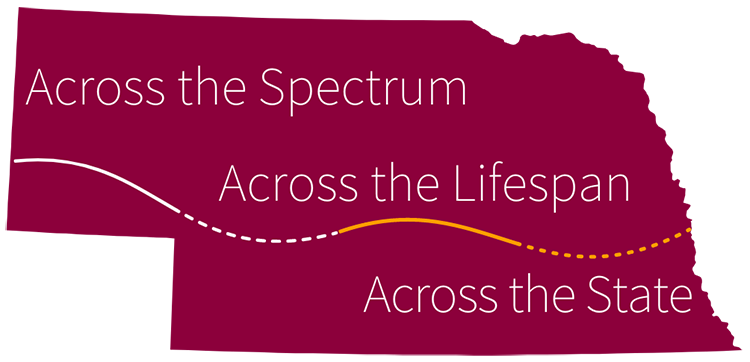What is Autism Spectrum Disorder (ASD)?

Autism Spectrum Disorder (ASD), hereafter referred to as Autism, is a complex, lifelong developmental condition that typically appears during early childhood and can impact a person’s social skills, communication, relationships, and self-regulation. The Autism experience is different for everyone. It is defined by a certain set of behaviors and is often referred to as a “spectrum condition” that affects people differently and to varying degrees.
While there is currently no known single cause of Autism, early diagnosis helps a person receive resources that can support the choices and opportunities needed to live fully.
Your doctor will encourage you to ask specific questions about your child’s developmental progress. The National Institute of Child Health and Human Development (NICHD) developed a detailed list of behaviors, listed in four categories: communication, social behavior, stereotyped behavior, and other behavior. Additionally, the Centers for Disease Control and Prevention (CDC) developed a list of Signs and Symptoms, which can be found here.
In many families, there appears to be a pattern of Autism or related disabilities, further supporting the theory that the disorder has a genetic basis.
While no one gene has been identified as causing Autism, researchers are searching for irregular segments of genetic code that people with Autism may have inherited. It also appears that some people are born with a susceptibility to Autism, but researchers have not yet identified a single “trigger” that causes Autism to develop.
Other researchers are investigating the possibility that under certain conditions, a cluster of unstable genes may affect brain development in an unexpected way, resulting in Autism. Still other researchers are investigating complications during pregnancy or delivery as well as environmental factors such as viral infections, metabolic imbalances, and exposure to chemicals.
The Centers for Disease Control and Prevention (CDC) released two reports (March 2023) from the Autism and Developmental Disabilities Monitoring (ADDM) network detailing prevalence rates, characteristics, and screening and diagnostic information. The CDC reports a continued increase in the prevalence rate with one in 36 children receiving an Autism diagnosis.
See the full prevalence and early identification reports published in the Morbidity and Mortality Weekly Report on the CDC website.
- 1 in every 36 children is receiving an Autism diagnosis. The increase to 1 in 36 eight-year-olds being diagnosed from the 2021 report of 1 in 44 eight-year-olds, can be attributed to a variety of factors, including an increased rate of diagnosis itself. This means that while diagnostic screening and identification are improving in some ways, the prevalence rate is also increasing.
- Children who receive an Autism diagnosis by age 4, are more likely to receive services that lead to improved long-term outcomes. This confirms the need to urgently increase our capability to screen and effectively diagnose children as early as possible; the Autism Society at least three times before age three (9, 18, and 24 or 30 months), so that they can be referred for services to have the best chance of success to live fully.
- The Autism Society, like the CDC, supports early identification as one of the most important tools communities have in helping to make a difference in the lives of children with Autism. The CDC’s Learn the Signs. Act Early. program promotes early identification by providing parents, childcare professionals, and healthcare providers free resources, in English and Spanish, for monitoring children’s development.
- The early identification report demonstrates that for the first time, the percentage of 8-year-old Asian or Pacific Islander, Hispanic, and Black children identified with Autism was higher than among 8-year-old White children. This change effectively closes the racial and ethnic gap which was observed and reported in previous ADDM reports. These shifts may reflect improved screening, awareness, and access to services among historically underserved groups.
Established in 2000, the ADDM Network is the only network to track the number and characteristics of Autistic children and other developmental disabilities in multiple communities throughout the United States. This data provides important information from which researchers, policymakers, and service providers are able to make important decisions about how to best serve these individuals and their families. However, it is important to note that these estimates are based on 8-year-old children living in 11 community sites, and do not reflect the entire population of children in the United States. The Autism Society of America has continuously urged the CDC to increase its population data by expanding the number of sites and diversity of populations. Learn more about the ADDM sites here .




